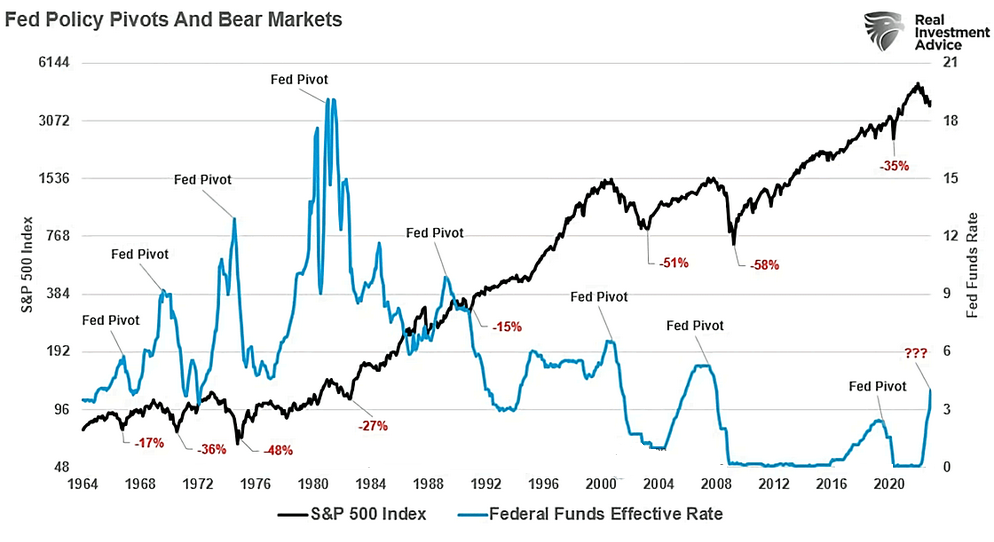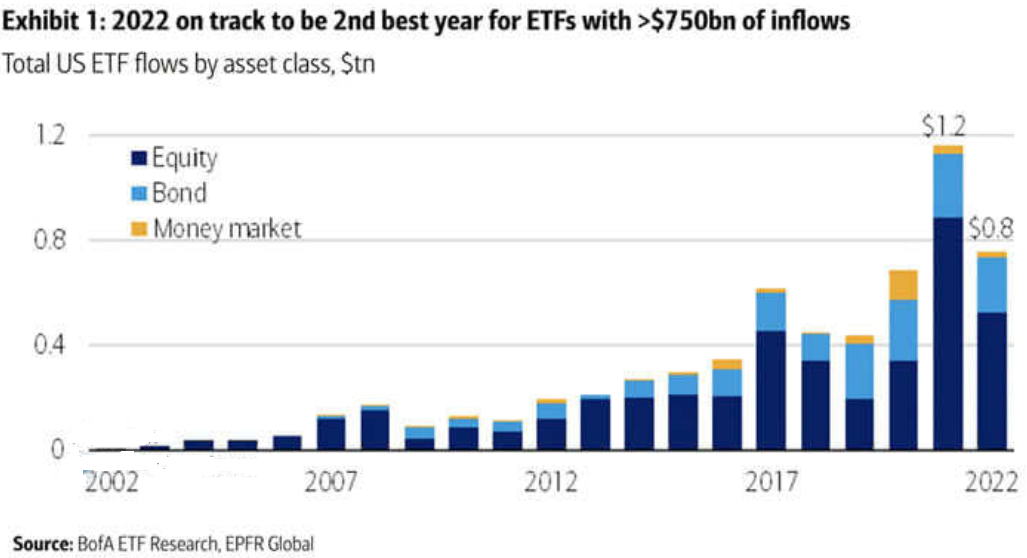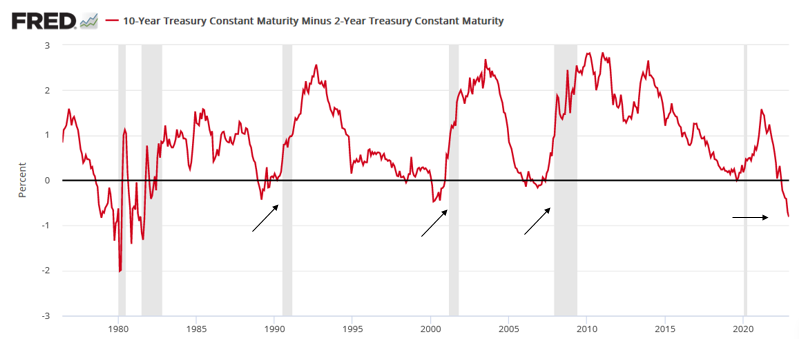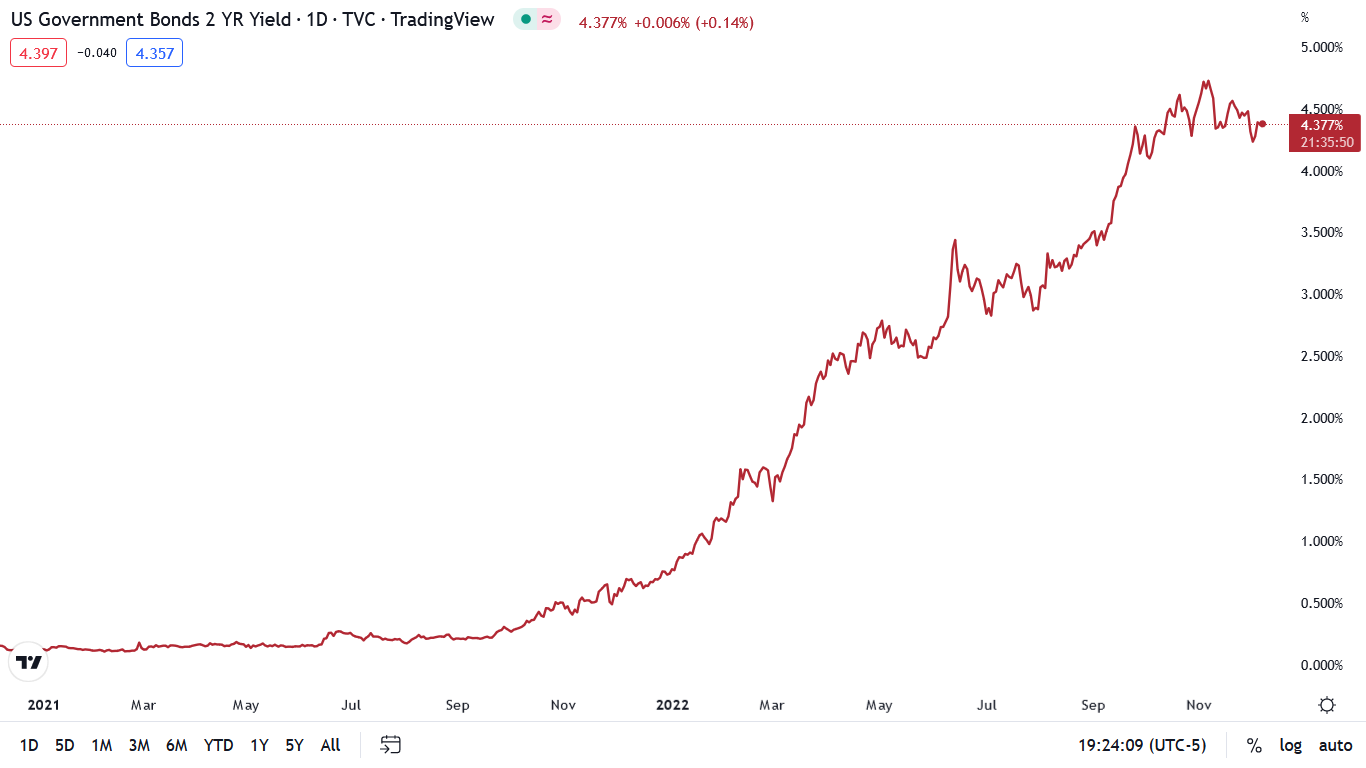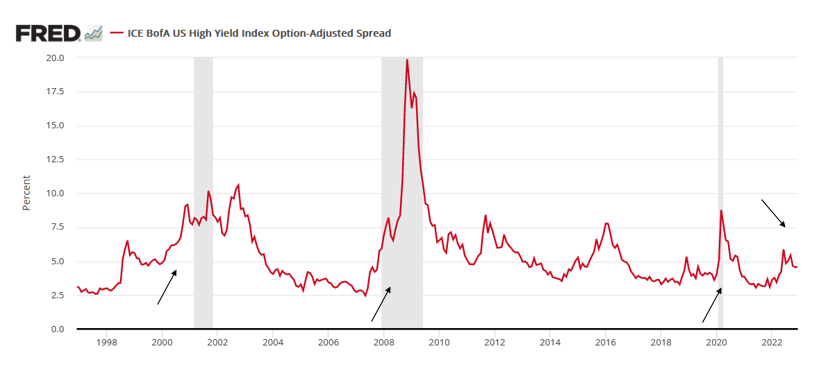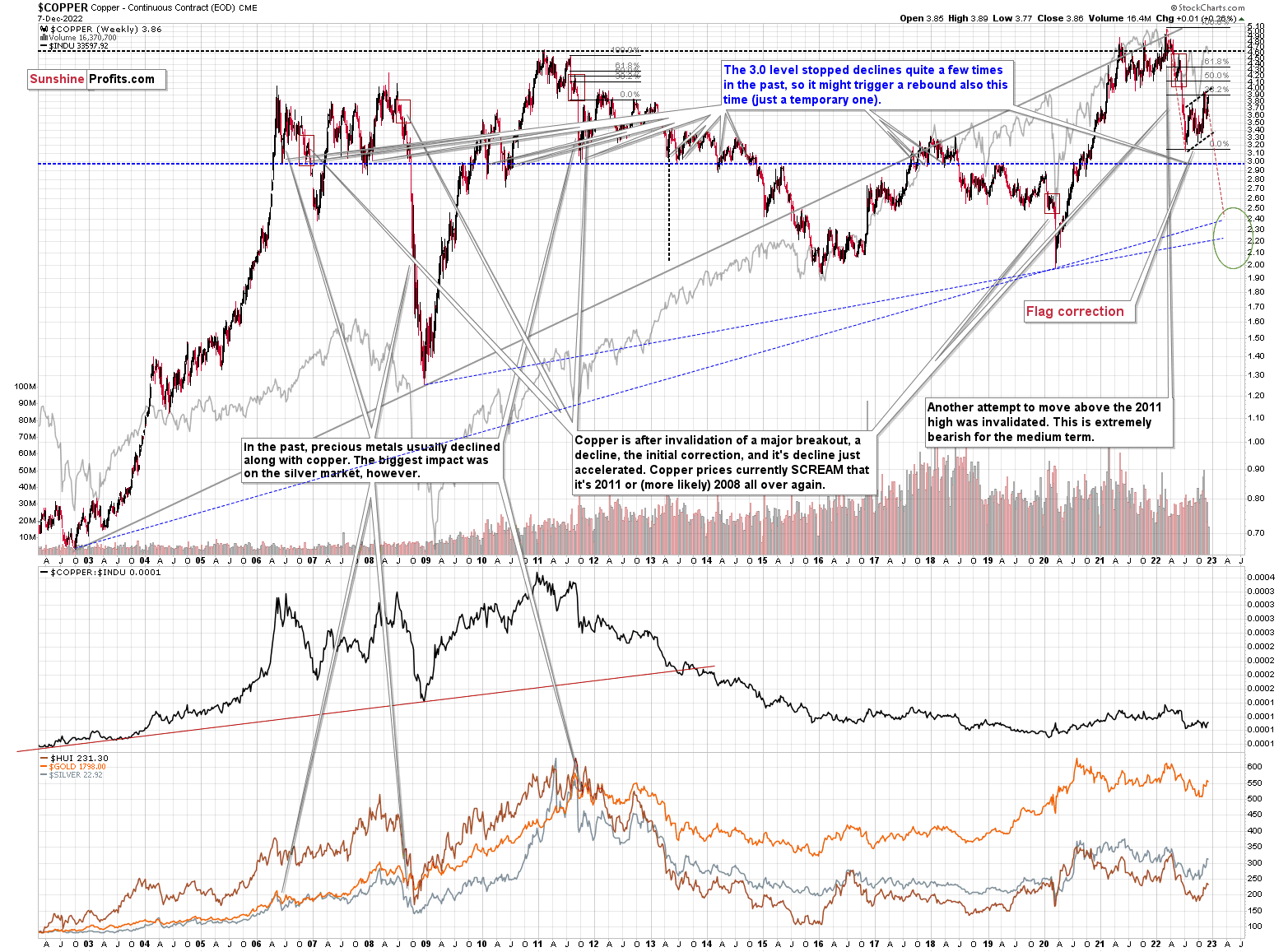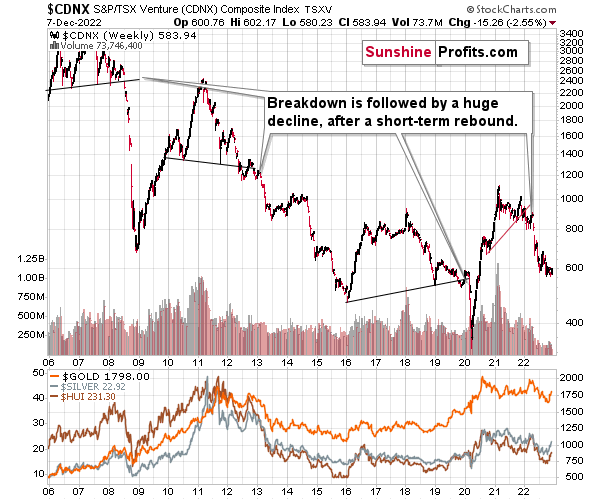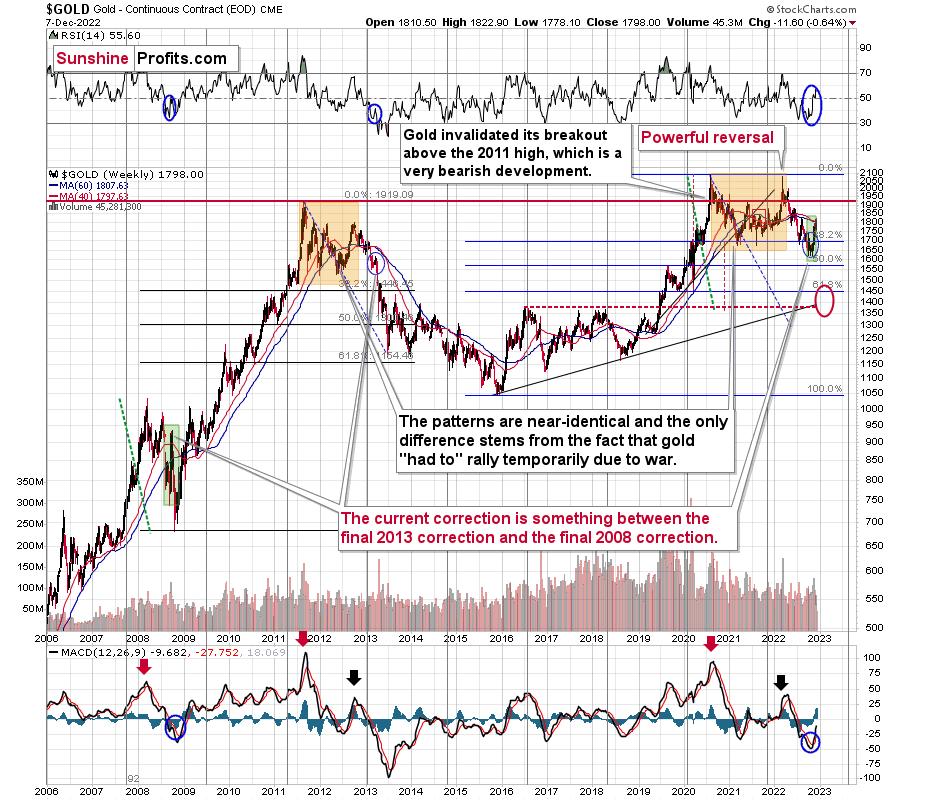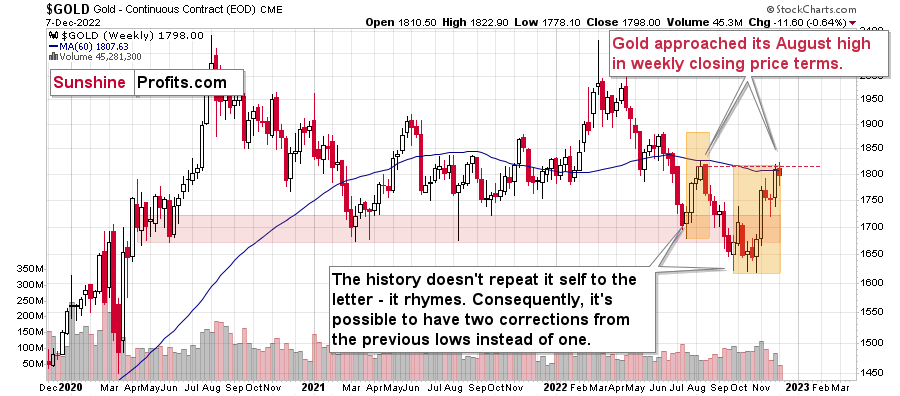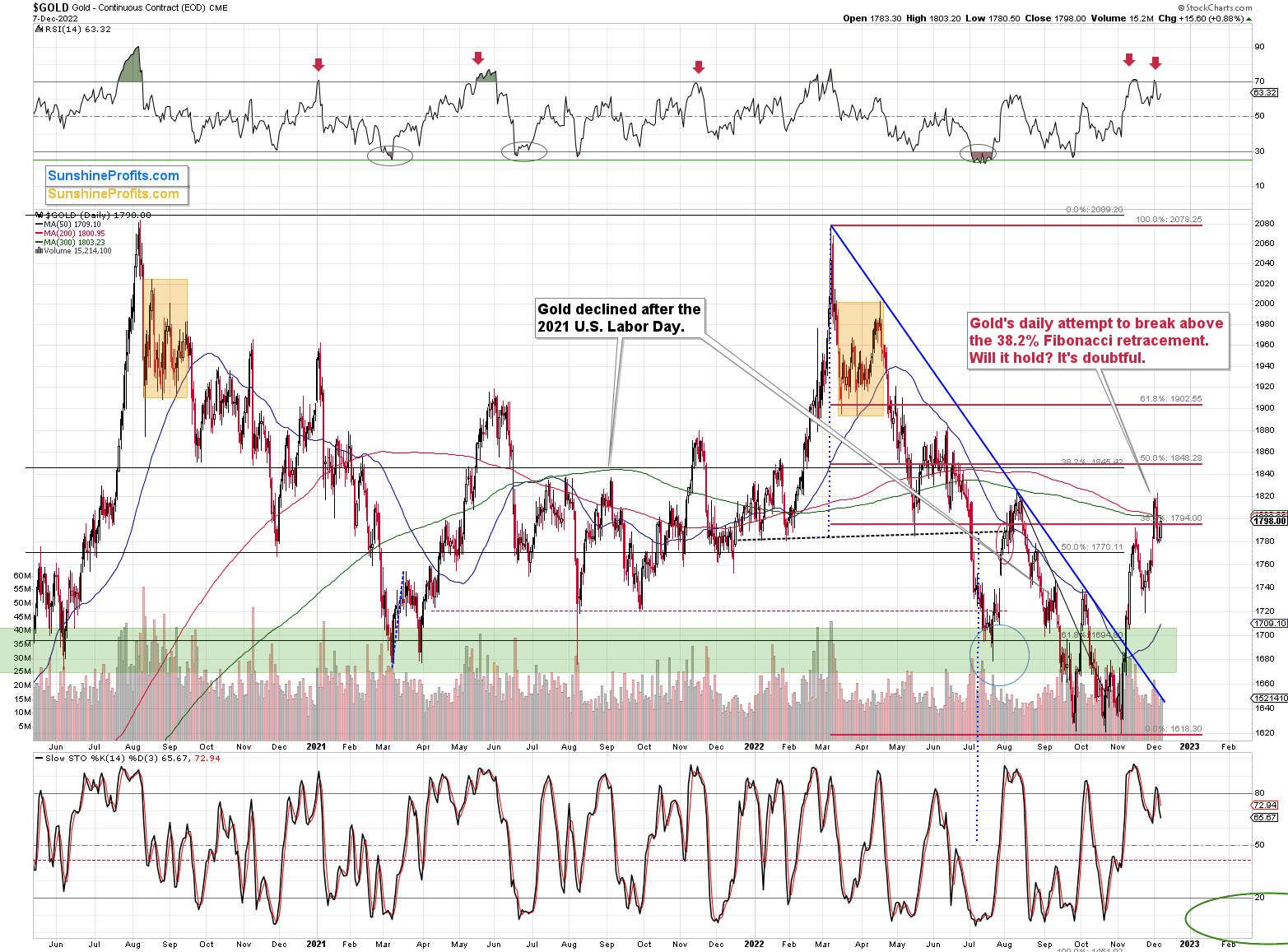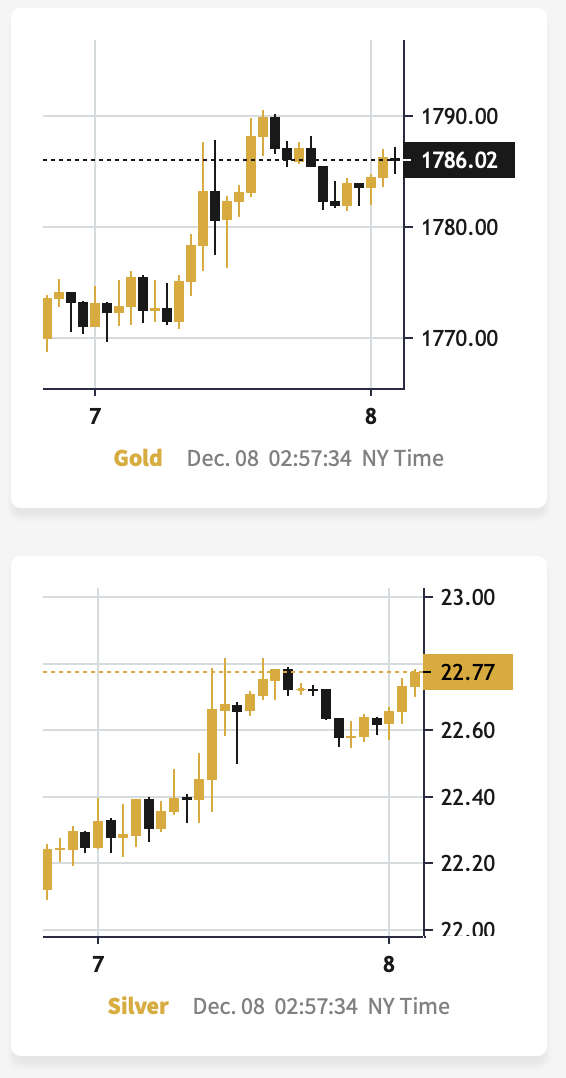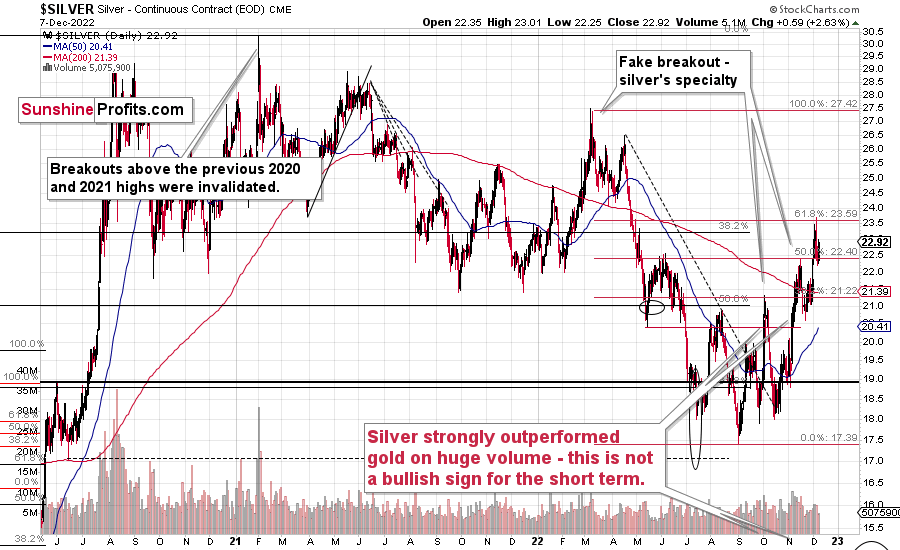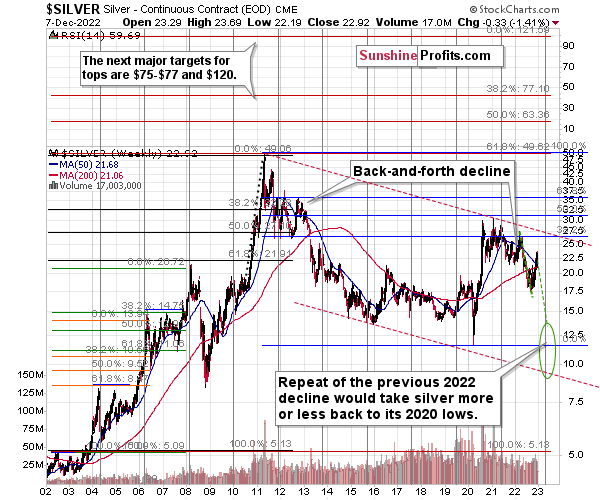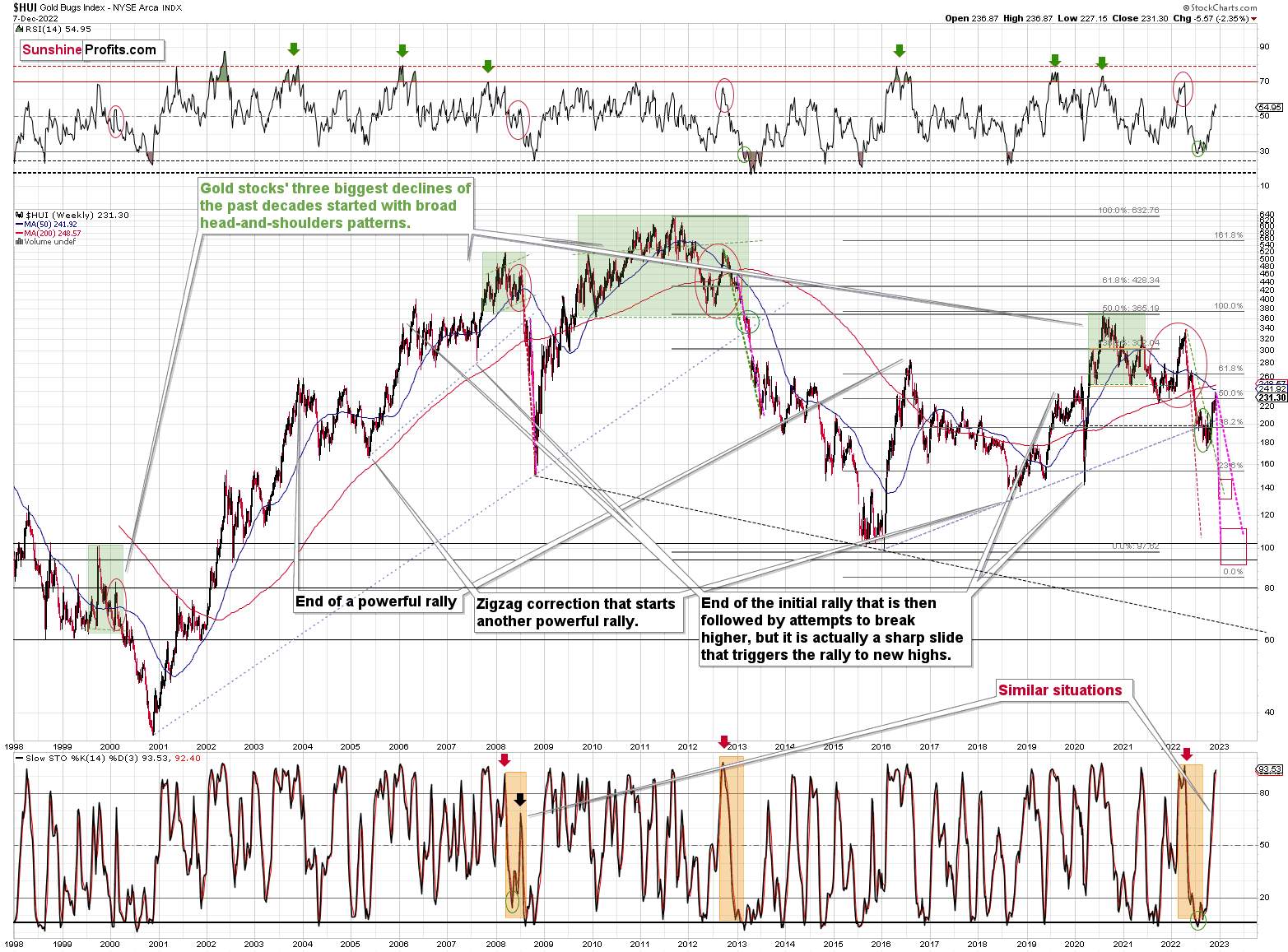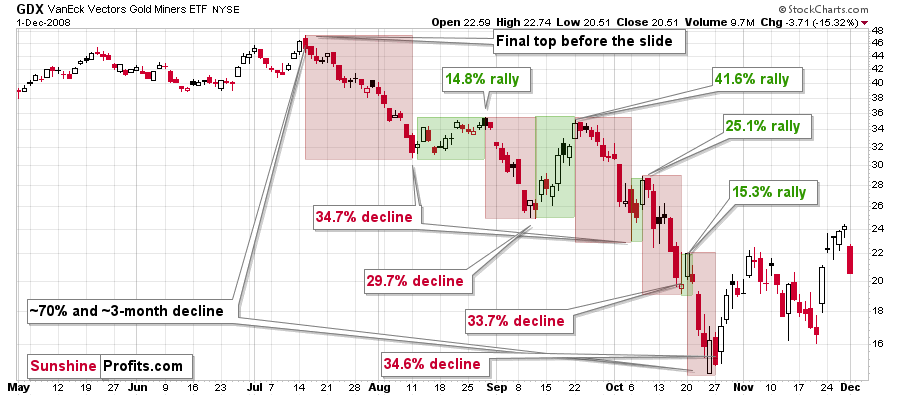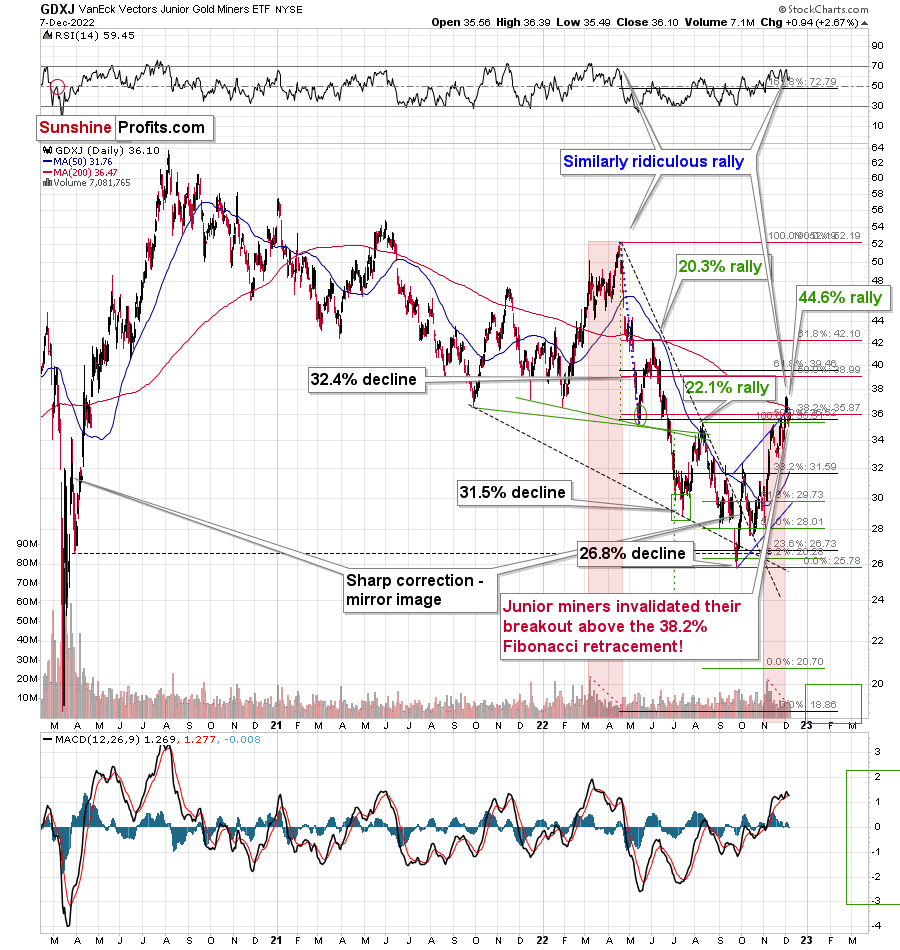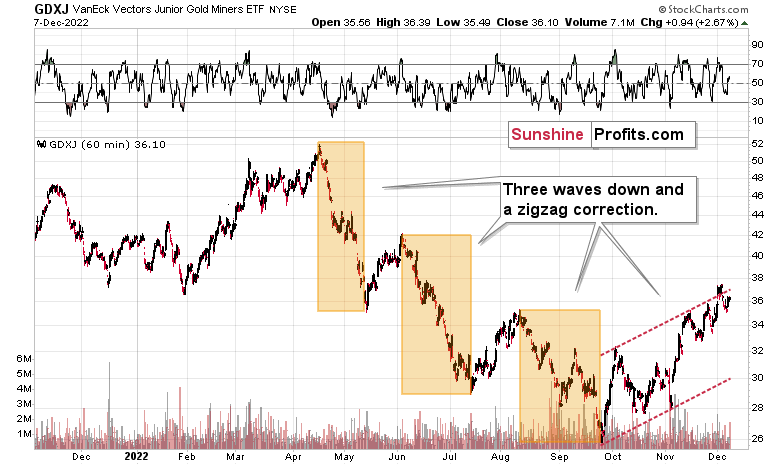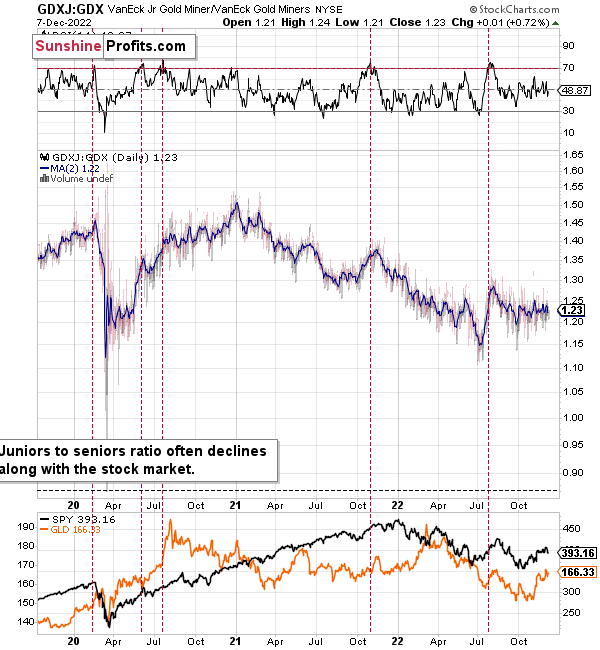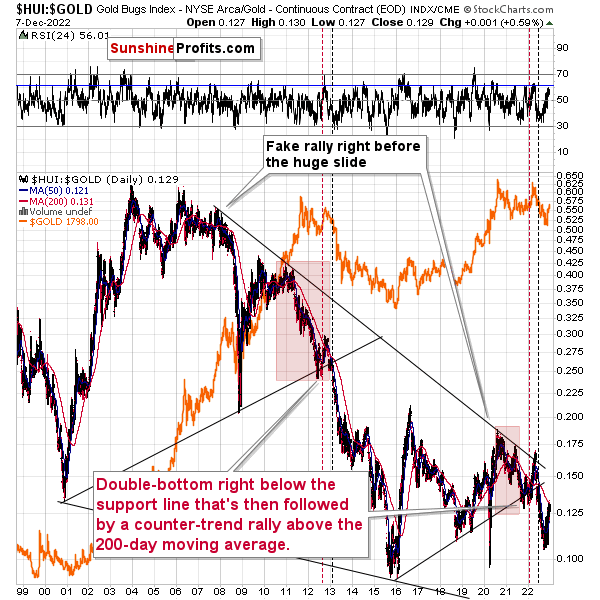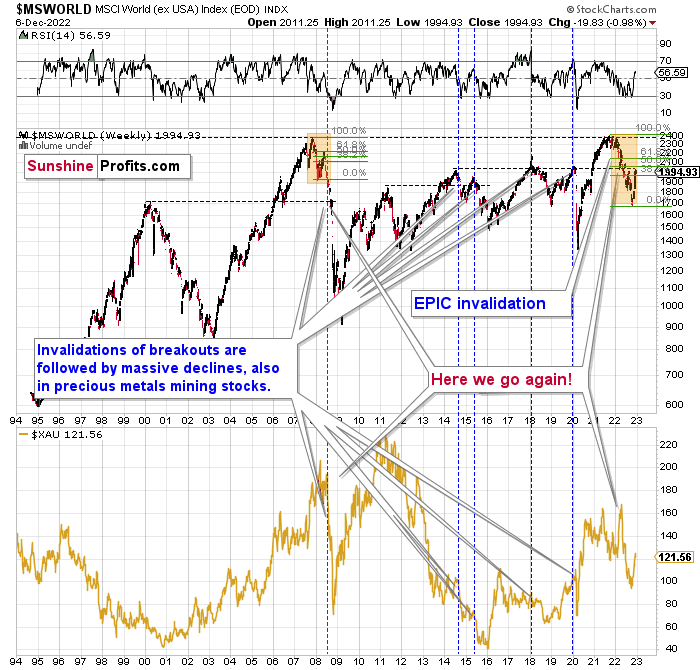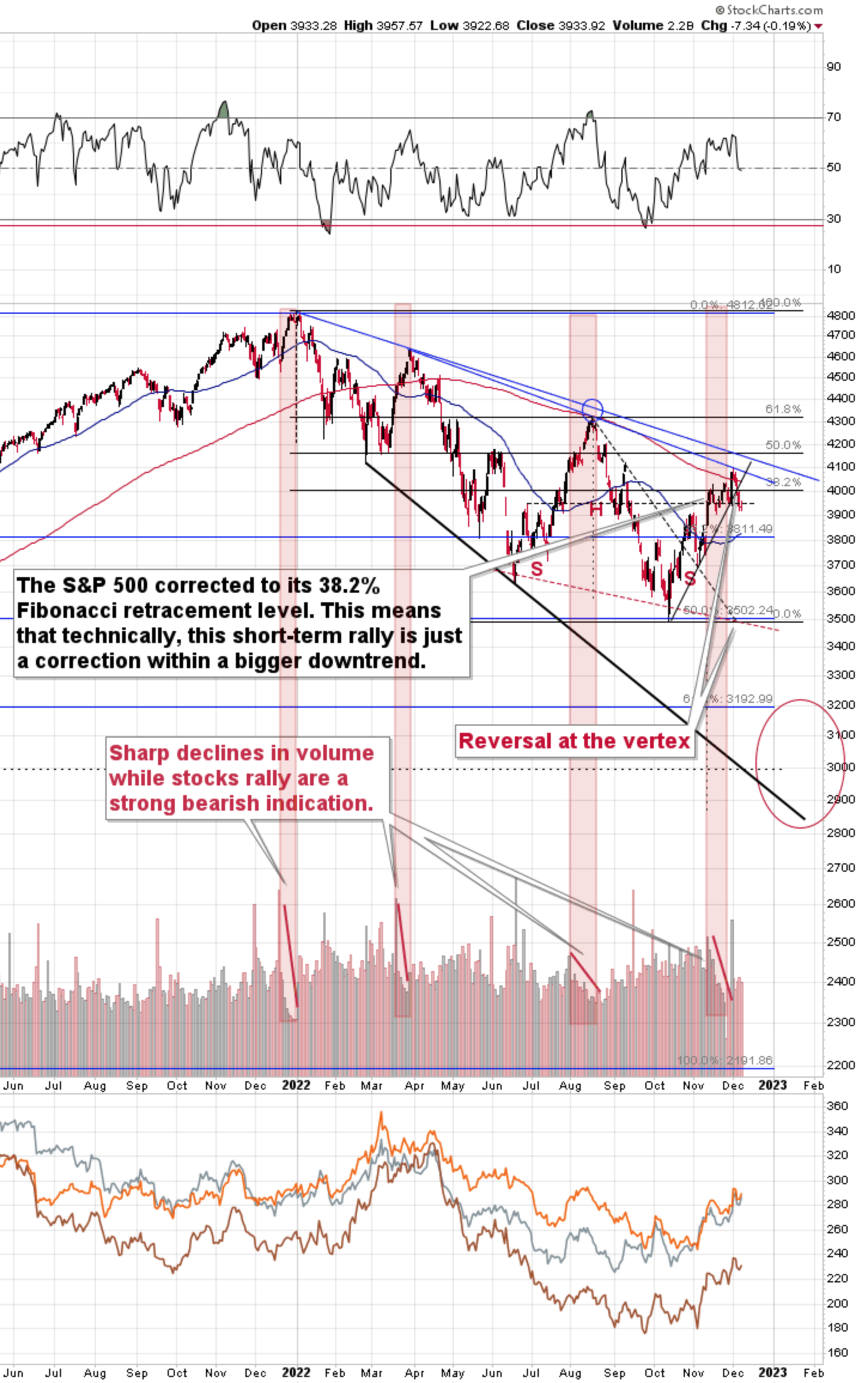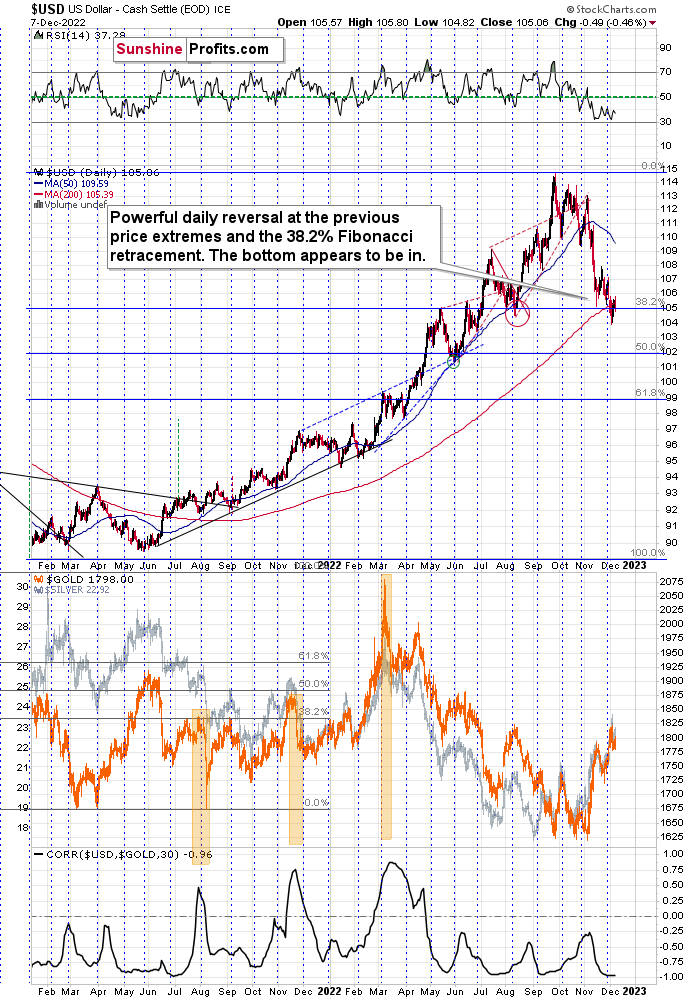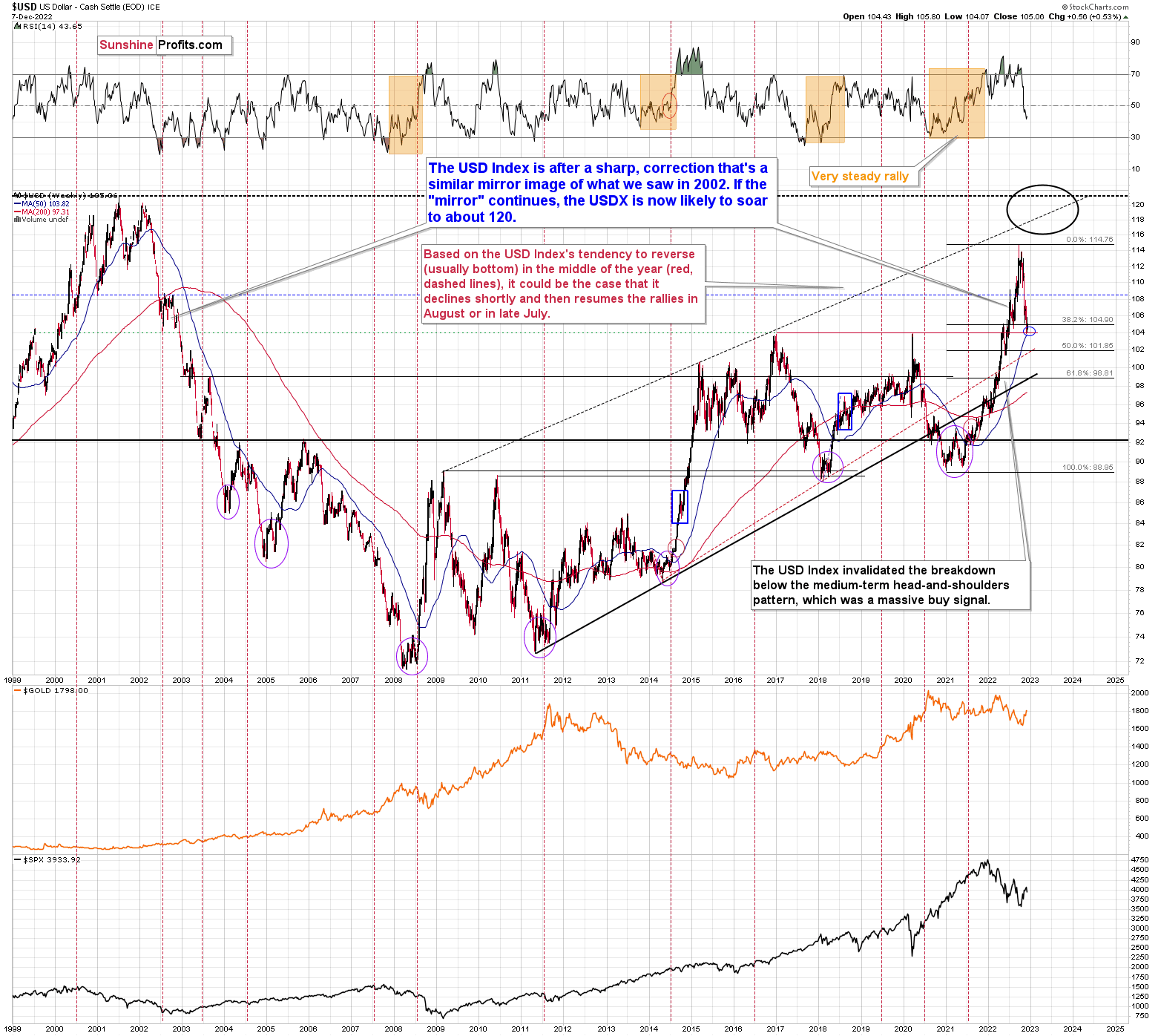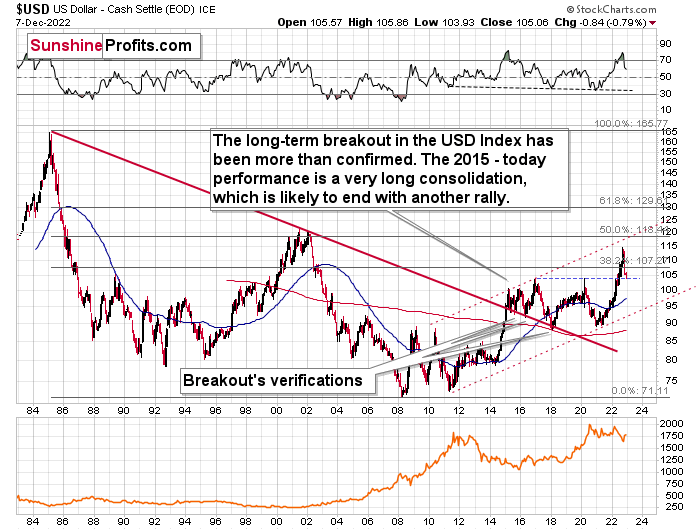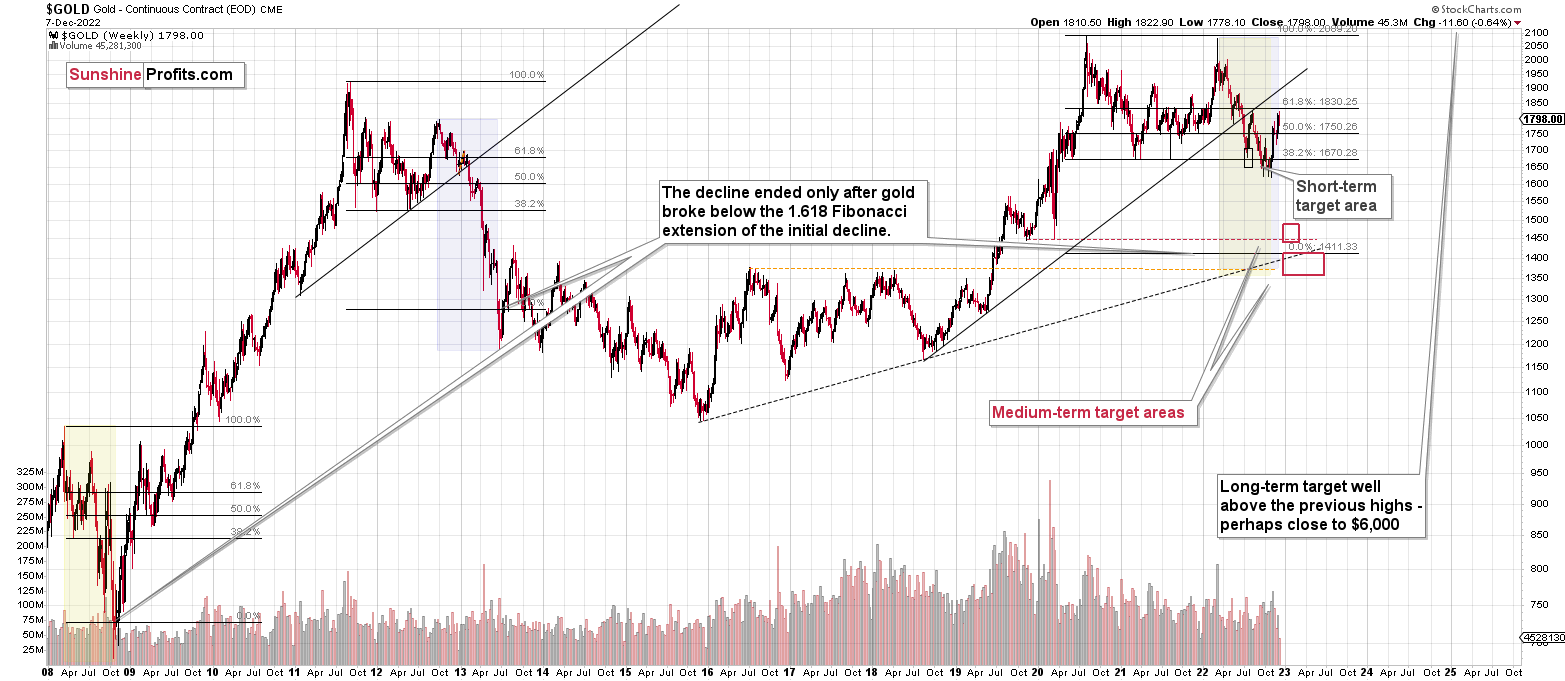Briefly: gold and the rest of the precious metals market are likely to decline in the next several weeks/months and then start another powerful rally. Gold’s strong bullish reversal/rally despite the USD Index’s continuous strength will likely be the signal confirming that the bottom is in.
Welcome to this week's Gold Investment Update. Our most recently featured medium-term outlook remains the same as the price moves align with our expectations (or at least are not really against them). On that account, there are parts of the previous analysis that didn’t change at all in the earlier days and are written in italics.
The key thing that happened this week is that markets (stocks, USD Index, gold, and miners) invalidated their previous moves through the 38.2% Fibonacci retracement. This is an indication that the correction that we saw in the past few months, is now over.
Let’s start today’s analysis with a recap of what recently happened on the fundamental front.
The Weekly Fundamental Roundup
With recession fears and economic uncertainty dominating the headlines this week, the S&P 500’s November optimism has seemingly vanished into thin air. However, with gold, silver and mining stocks remaining relatively uplifted, the negativity has not impacted the PMs to the same extent; and with their relative strength largely driven by the consolidations of the USD Index and the U.S. 10-Year real yield, the pair’s pullbacks have provided the precious metals with short-term fuel.
But, with sharp reversals poised to materialize over the medium term, inflation, higher interest rates and a potential recession should weigh heavily on the PMs’ performances.
Is Gold Seeing Pivot Stars?
Despite another down day for the S&P 500, the gold price headed in the opposite direction. Moreover, with interest rates declining as recession fears mount, the crowd can’t decide whether lower Treasury yields are bullish or bearish.
In addition, with the Bank of Canada (BoC) unsure of its next step, uncertainty has market participants in a state of confusion. For example, the BoC raised its overnight lending rate by 50 basis points on Dec. 7.
Please see below:
The official press release read:
“GDP growth in the third quarter was stronger than expected, and the economy continued to operate in excess demand. Canada’s labour market remains tight, with unemployment near historic lows. While commodity exports have been strong, there is growing evidence that tighter monetary policy is restraining domestic demand: consumption moderated in the third quarter, and housing market activity continues to decline.”
As a result:
The “Governing Council will be considering whether the policy interest rate needs to rise further to bring supply and demand back into balance and return inflation to target.”
So, while the BoC cited “excess demand” and “unemployment near historic lows,” and in the next breath, questioned “whether the policy interest rate needs to rise further,” the contradiction highlights the conundrum confronting North American central banks. With some areas of their economies running too hot, while others are too cold, they want to have their cake and eat it too.
However, the reality is that supporting growth encourages inflation, and history shows the gambit ends in a recession regardless of what they do; and while the BoC (and maybe the Fed next week) thinks the overnight lending rate could peak at 4.25%, we believe the central bank materially underestimates the challenges that lie ahead.
To that point, Bridgewater Associates’ Chief Investment Strategist Rebecca Patterson said on Dec. 5:
“While there is going to be this tug of war how much the Fed will accept inflation versus force inflation to its target, how much growth pain will we get, we continue to believe that there's another shoe that has to drop, and that is the economy.”
She added:
“What's not priced in is the Fed going high, and holding. The market's anticipating right now that we get significant rate cuts starting in the second half of next year, and we think without severe economic weakness to justify that, we're going to get the Fed pausing, but not cutting.”
Thus, while Bridgewater Associates sees things from our perspective, Patterson noted that a 5% U.S. federal funds rate (FFR) should be the minimum, and a higher peak shouldn’t be dismissed.
Please see below:
As such, while gold is priced as if rate cuts and QE are on the horizon, the opposite should occur over the medium term. Furthermore, with growth, employment and consumer spending still resilient, the outlook is bullish for the FFR and bearish for silver. For context, you can read more about silver’s reaction to the latest U.S. nonfarm payrolls report here.
In addition, while the crowd believes that a dovish pivot is a good thing, they don’t realize that real pivots occur when the U.S. economy is collapsing, not when the unemployment rate is near a 50-year low. Therefore, when the Fed finally relents, it’s profoundly bearish.
Please see below:
To explain, the blue line above tracks the FFR, while the black line above tracks the S&P 500. If you analyze the annotations, you can see that historical pivots culminated with sharp drawdowns of the index. So, while the crowd believes that the Fed can flip a switch and cure all of the financial market's ills, the sentiment is much more semblance than substance.
Yet, while the data disproves the narrative, investors continue to pour money into U.S. equity ETFs.
Please see below:
To explain, the dark blue, light blue and orange bars above track the annual inflows into stocks, bonds and money market ETFs. If you analyze the right side of the chart, you can see that the dark blue bar hit its second-highest level in the last ~20 years in 2022, and was only surpassed by 2021.
As a result, there is little fear in the financial markets, and the crowd has supreme faith in the Fed. For your reference, fundamental data have medium to long-term ramifications, so for more technical insights, please see our stock price analysis.
Overall, while the consensus expects a recession and assumes a dovish pivot will arrive soon, the price action contrasts the narrative. In reality, when dovish pivots occur, the economic outlook is so dire that asset liquidations are already underway.
In contrast, they don’t occur with a near-record-low unemployment rate, near-record-high wage inflation and ~40-year high output inflation. Consequently, while the post-GFC pivots made it seem like the Fed could solve any problem, it’s much different when inflation is ~4x the annual target.
Silver Shines as the Price Keeps Climbing
While breakeven inflation rates collapse and recession fears mount, silver has defied all logical expectations. For example, the white metal is more economically-sensitive than gold, and historical recessions have resulted in epic drawdowns. As such, the fundamental dissonance highlights the momentum in play.
However, while recession calls were loud in the summer, they proved materially early; and with more misguided concerns present now, the recent decline in U.S. Treasury yields should reverse like they did then. To explain, we wrote on Dec. 7:
The red line above tracks the U.S. 10-2 spread, which subtracts the U.S. 2-Year Treasury yield (2Y) from the U.S. 10-Year Treasury yield (10Y). In a nutshell: when the 2Y exceeds the 10Y, it's the bond market's way of warning about a forthcoming recession; and the development occurs because the 2Y is pricing in a higher FFR, while the 10Y is pricing in weaker economic growth.
…. The three arrows in the middle show that the 10-2 spread moved from negative to positive before the last three recessions occurred; and this happens because the 2Y falls by more than the 10Y, as investors start pricing in Fed rate cuts. For context, the 1980s was a mixed picture, as two recessions had the spread moving in and out of positive territory.
The important point is that the 10-2 spread is becoming more negative, and the last three recessions did not occur when the spread was declining.
We added:
The 2Y needs to demonstrate substantial weakness, where economic carnage causes bond investors to bid the 2Y Note in anticipation of the Fed cutting interest rates. Yet, this is far from the current backdrop.
Please see below:
To explain, the red line above tracks the 2Y, and if you analyze the right side of the chart, you can see that the metric remains in consolidation. Therefore, its behavior does not add credibility to the recession rhetoric.
So, while the narrative proclaims a recession is imminent, and rate cuts and QE are near, the recent data and the bond market's behavior do not support the arguments. Remember, the last three times the 10-2 spread turned negative, the recessions arrived ~12 to ~22 months later; and with the current 10-2 spread turning negative in early July, we're only ~five months into the current inversion. Thus, patience is warranted.
As further evidence, the behavior of high yield credit spreads signal that the U.S. economy is much healthier than the narrative suggests.
Please see below:
To explain, the red line above tracks the ICE/Bank of America U.S. High Yield Option-Adjusted Spread (OAS). For context, the metric measures the excess interest rate over U.S. Treasury yields charged to the riskiest U.S. companies, while also removing the impact of embedded options.
In a nutshell: the least credit-worthy companies operate in high yield land, and they are the most economically sensitive and have the highest probability of default.
If you analyze the left side of the chart, you can see that the red line spiked before the 2001 and 2007 recessions began. A somewhat similar development was present in 2020, though the pandemic-induced recession was more of a surprise.
The key point is that when the U.S. economy is about to crumble, high yield spreads increase dramatically to reflect the higher default risk. Yet, if you turn your attention to the right side of the chart, you can see that the red line has been in a downtrend since July.
As a result, bond investors are not worried about their high yield borrowers’ ability to pay, and if a recession was imminent, default anxiety would be rising. So, while the silver price has rallied sharply in anticipation of a lower FFR, that optimism should unravel in the months ahead.
To that point, the Conference Board released its Employment Trends Index (ETI) on Dec. 5. The index declined from 118.74 in October to 117.65 in November. But, Frank Steemers, Senior Economist at The Conference Board, said:
“The labor market is currently still robust….The demand for workers is still resilient and wage growth continues to be elevated. With the number of employees quitting still high – and the labor supply still constrained – employers may continue to offer strong pay increases to their existing workers and new hires over the coming months.
“However, with the economy expected to slow further in 2023 amid the Federal Reserve’s rapid interest rate hikes, we expect the US labor market to cool and possibly even record some monthly job losses.
“That said, labor shortages are unlikely to disappear altogether, with the unemployment rate projected to rise from the current 3.7 percent to a still-low 4.5 percent in 2023. Employers may still need to manage recruitment and retention difficulties, as well as rising labor costs, into the New Year and beyond.”
Therefore, with Americans still gainfully employed and spending money at durable rates, it’s essential to distinguish a slowdown from a recession. Yes, the rapid rise in the FFR has slowed the U.S. economy, and that was the intention. In contrast, many metrics are nowhere near levels that would normalize inflation from ~8% to 2%.
Consequently, we believe the Fed still has plenty of work to do, and the medium-term outlooks are bullish for the FFR, real yields and the USD Index. Conversely, the silver price should suffer mightily when these metrics resume their medium-term uptrends.
For a more thorough breakdown of the precious metals market, please see our comprehensive technical analysis that covers gold, silver, mining stocks, the S&P 500 and more. Remember, the fundamentals are only one part of our investment thesis, and they are best used in conjunction with the technicals.
The Bottom Line
While gold, silver and mining stocks have outperformed the S&P 500 in recent days, the pain confronting stocks and crude oil should impact the PMs sooner rather than later. Furthermore, even though the narrative is misguided, the recession fears dragging down the S&P 500 are not bullish for the PMs.
Historically, recessions culminate with large-scale liquidations, and silver and mining stocks suffer the most; and while the crowds’ recession calls may be a few quarters early, the clock is ticking, and investors are unlikely to respond positively when the drama unfolds.
In conclusion, the PMs rallied on Dec. 7, as a weaker USD Index and a lower U.S. 10-Year real yield increased their fundamental attractiveness. However, with prior pullbacks resulting in new highs for both metrics, we expect a similar outcome over the medium term. As a result, the PMs are likely far from their final lows.
What to Watch for Next Week
With more U.S. economic data releases next week, the most important are as follows:
- Dec. 13: Consumer Price Index (CPI), NFIB Small Business Optimism Index
The CPI is always highly anticipated, and the sharp decline in the crude oil price in November could provide a short-term reprieve. But, the medium-term ramifications are not determined by one month’s print. The NFIB’s index is also material, as the wage and inflation metrics often lead the future government data.
- Dec. 14: FOMC meeting, Jerome Powell press conference
While the FOMC is expected to raise the FFR by 50 basis points, it will be interesting to see if Powell strikes a dovish tone. With the BoC avoiding future rate hike commitments (which is a mistake), Powell may also adopt a wait-and-see approach. Either way, his words can’t change the medium-term fundamental outlook.
- Dec. 15: U.S. retail sales, New York and Philadelphia Fed manufacturing indexes
U.S. retail sales hit an all-time high in October, and continued strength is bullish for the FFR. In addition, the growth, employment and inflation results from the Fed’s regional PMIs are also worth monitoring.
- Dec. 16: S&P Global U.S. Composite PMI
S&P Global conducts a nationwide survey, and the results will help determine if/when the U.S. labor market falters.
All in all, economic data releases impact the PMs because they impact monetary policy. Moreover, if we continue to see higher employment and inflation, the Fed should keep its foot on the hawkish accelerator. If that occurs, the outcome is profoundly bearish for the PMs.
Technically Speaking
Let’s start today’s technical discussion with a quick check of copper prices.
Overall, everything I wrote about it last week remains up-to-date:
Copper recently CLEARLY invalidated another attempt to move above its 2011 high. This is a very strong technical sign that copper (one of the most popular commodities) is heading lower in the medium term.
No market moves up or down in a straight line (well, the 2008 slide appears to have been an exception), and a short-term correction doesn’t necessarily invalidate the bigger trend. For the last couple of months, copper has been trading sideways, but it didn’t change much regarding the outlook.
In fact, it made my previous target area even more likely. You see, the consolidation patterns are often followed by a move that’s similar to the move that preceded them. In this case, the previous 2022 decline was quite significant, and if it is repeated, one can expect copper to decline well below 3.
Actually, copper could decline profoundly and bottom in the $2.0-2.4 area. That’s where we have rising, long-term support lines and also the previous – 2016 and 2020 – lows.
Flag patterns (which we just saw in copper) tend to be followed by price moves that are similar to ones that preceded them. I marked this on the above chart with red, dashed lines. This method supports a copper price’s move to around $2.4.
Given the recent flag pattern and the size of the previous decline (and its pace), it seems quite likely that it could take another 2-7 months for copper to move to about $2.4. Late March / early April seem the most likely time target given the current data.
Interest rates are going up, just like they did before the 2008 slide. What did copper do before the 2008 slide? It failed to break above the previous (2006) high, and it was the failure of the second attempt to break higher that triggered the powerful decline. What happened then? Gold declined, but silver and mining stocks truly plunged.
Again, copper is after invalidation of a major breakout, a decline, and a correction. Copper prices currently SCREAM that it’s a variation of 2008 all over again. This is extremely bearish for mining stocks (especially juniors) and silver.
Having said that, let’s check junior miners’ really big picture.
I previously commented on the above chart in the following way:
The Toronto Stock Exchange Venture Index includes multiple junior mining stocks. It also includes other companies, but juniors are a large part of it, and they truly plunged in 2008.
In fact, they plunged in a major way after breaking below their medium-term support lines and after an initial corrective upswing. Guess what – this index is after a major medium-term breakdown and a short-term corrective upswing. It’s likely ready to fall – and to fall hard.
So, what’s likely to happen? We’re about to see a huge slide, even if we don’t see it within the next few days.
One thing that I would like to add today is that just like it was the case in 2008, the move higher that we saw before the final (biggest) slide in gold, silver, and gold stocks (lower part of the chart), we didn’t see a visible rally in the TSX Venture Index. Just as the index paused back then, it paused right now.
Currently, it’s trading at about 600, and back then, it consolidated at about 2500. The price levels are different, but the overall shape of the price moves (lack thereof) is similar. This serves as a signal, that the recent upswing in the PMs was not to be trusted.
The above is one of the weakest (from the technical point of view) charts that is see across the board right now. There is a strong long-term downtrend visible in the TSX Venture Index, and if stocks slide similarly as they did in 2008, the TSXV could truly plunge – perhaps even to the 300 level or lower.
Having said that, let’s turn to gold.
Let’s start with context:
Between 2020 and now, quite a lot happened, quite a lot of money was printed, and we saw a war breaking out in Europe. Yet gold failed to rally to new highs.
In fact, it’s trading very close to its 2011 high, which tells you something about the strength of this market. It’s almost absent.
Truth be told, what we see in gold is quite in tune with what we saw after the 2011 top, and in particular, shortly after the 2012 top. We can also spot similarities between now and 2008. The long-term gold price chart below provides details.
Looking at the gold market from a broader point of view, the corrective upswing that we saw recently is something between what we saw in 2013 and what we saw in 2008.
The recent move higher was bigger than what we saw in 2013 but smaller than what we saw in 2008.
No wonder – the current situation in general is similar to both. In fact, that’s why I’ve been writing about this dual similarity for many months now.
Back in 2013, the final of the pre-slide corrective upswings ended with gold below its 40- and 60- week moving averages (marked with red and blue, respectively).
Back in 2008, the final of the pre-slide corrective upswings took gold visibly above both above-mentioned moving averages.
And now? We saw a move above both moving averages, but only a bit above them – the move was not as profound as the one that we saw in 2008.
The most interesting thing about the above is that when gold did finally move above those moving averages in 2008, it meant that the rally was practically over and that it was the perfect time to be shorting the precious metals market – especially mining stocks.
Now, as far as the link to 2013 is concerned, it remains perfectly intact, with the additional note that the final corrective upswing is bigger this time – more like what we saw in 2008.
Gold is sometimes forced to react to some geo-political events as the safe-haven buying kicks in, but these moves are usually short-term lived. Looking at long-term charts helps to keep things in proper perspective.
Consequently, my previous comments remain up-to-date:
Based on the above chart, it’s quite clear that the situation that is now being repeated. The patterns marked with orange rectangles and blue ellipses are almost identical (also in the MACD indicator, and to a lesser extent in the RSI indicator).
Sure, the situations are not identical, as this time we had a Russian invasion of Ukraine that pushed gold temporarily higher. Other than that, the situations are extremely similar.
Based on the stage of the self-similarity and the confirmed breakdown below the $1,700 level, gold is now likely to slide.
Based on the analogy to 2013, it’s not only likely to slide, it’s likely to slide profoundly in a sharp manner. These may be the last days or hours before the slide fully begins.
How low is gold likely to go during this upcoming big medium-term decline? Perhaps as low as its 2020 low, around $1,450-1,500. Then, after a rebound, quite likely to be at or slightly below $1,400.
I realize this is far from the current price, but nonetheless, this target area appears justified in my opinion. There are two important Fibonacci retracements based on the 2015-2020 rally that gold can bounce from (it recently bounced from the 38.2% retracement). These are 50% and 61.8% retracements.
The support provided by the 61.8% retracement is strengthened by the 2020 low and the support provided by the 50% retracement is strengthened by the 2019 high.
However, based on gold’s self-similarity to 2013, it seems that we’re about to see a slide that’s bigger than what we’ve been seeing so far this year. This time – based on the similarity – gold is likely to decline profoundly, but no longer in the back-and-forth mode. If gold formed its next local low at the 50% retracement (so at about $1,560), then it might do so still within the declining, short-term trend channel (sometime in September).
However, if gold is to stick to the link to 2013, then it should decline more rapidly. In this case, the technique that can help us estimate the short-term target is the one that says that after a breakdown from a trend channel, price is likely to move approximately by as much as the height of the previous trend channel. In this case, gold could break below the trend channel soon and then decline even more. Based on the height of the trend channel, the above means that a move to the 61.8% retracement as the next downside target is more likely than a move to the 50% retracement.
I previously wrote that the above-mentioned decline in gold would likely be linked to a breakdown in the EUR/USD below 1, and we already saw both: decline in gold, and a breakdown in the EUR/USD below 1. The implications remain bearish.
Having said that, let’s zoom in to see gold’s short-term price moves.
Gold’s rally was just stopped by the resistance provided by its previous high and its 60-week moving average). Will gold now reverse?
The above chart features gold price in terms of weekly candlesticks. As you can see, it just approached its August high.
And gold failed to move above it.
Last week, I wrote:
The resistance is provided by the weekly closing prices, and since the current week ends today (Dec. 2), it’s likely that gold’s rally was just stopped or that it will be stopped today.
The resistance held.
This week is not yet over, so don’t let the small size of this week’s volume fool you – it’s most likely not the case that gold is simply taking a breather. Zooming in provides extra details.
Gold, just like many other markets (i.a. stock prices), recently corrected slightly more than 38.2% of its previous move. And then it invalidated this small breakout.
During yesterday’s session, gold moved above this level once again, but only insignificantly so, and given the recent invalidation it’s unlikely that gold would be able to rally further.
If you click on the above chart and zoom it, you’ll see that right after the August top formed, gold also made a low-volume attempt to move higher. That was right before the start of the near $200 downswing.
The above happened even without the prior sell signal from the RSI indicator, and since we just saw the latter, a bearish outcome is even more likely.
Not to mention another signal from the silver-to-gold link (chart courtesy of https://goldpriceforecast.com/).
Silver, moved to its yesterday’s intraday high, while gold didn’t.
Silver once again moved higher to a much bigger extent than gold did in today’s pre-market trading, and while the size of both moves is not huge, it’s something that confirmed the previous indications, and it’s a bearish sign.
Why would silver’s outperformance be a bearish sign?
First of all, because the history shows that it worked numerous times.
Second, the silver market is much smaller, and it’s much popular with individual investors / investment public. The institutions simply can’t buy a lot of silver without moving the market, so they are not that interested in it – besides, it hasn’t performed well in the past decade. Individual investors, however, can usually freely enter the silver market, and due to multiple reasons, they often do.
The thing is that the investment public is often the last to the party – individual investors often buy close to tops, and they sell close to bottoms.
And you can see this in the price movement – silver soars relative to gold close to tops in their prices.
Since we just saw it in today’s pre-market trading, it serves as a bearish confirmation.
Having said that, let’s take a closer look at the silver market.
Just as gold moved above its 38.2% Fibonacci retracement level, silver moved above its 61.8% retracement. And then it invalidated this breakout, which is a sell sign.
Silver is known for fake breakouts, and I marked two of those on the above chart. The 2021 top qualifies as a “fakeout” as well.
Why am I writing this? To emphasize that silver’s breakout on its own is not a reason to be bullish, because of the above-mentioned bearish nature of its outperformance.
And given gold’s invalidation of its breakout, silver’s “strength” appears to be nothing more than the bearish indication that we’ve seen so many times before.
When looking at silver from a long-term point of view, it’s still obvious that the recent move higher was most likely just a corrective upswing.
What happens after corrections are over (as indicated by, i.e., silver’s outperformance)? The previous trend resumes. The previous trend was down, so that’s where silver is likely headed next.
Besides, the long-term turning point for silver is due in several months, and if silver repeats its previous 2022 decline, then it will bottom close to the turning point and also close to its 2020 low – in the first half of 2023.
It’s likely to repeat its previous 2022, because that’s what tends to happen after flag patterns, and what you see on silver’s short-term chart between September and yesterday appears to be a flag pattern.
Consequently, the current silver price forecast remains bearish, as does the outlook for the rest of the precious metals sector.
Let’s not forget that rising interest rates are likely to negatively impact not just commodities, but practically all industries. This will likely cause silver’s price to decline profoundly, as silver’s industrial demand could be negatively impacted by lower economic growth (or a decline in economic activity).
Consequently, it seems that silver will need to decline profoundly before it rallies (to new all-time highs) once again.
Having said that, let’s take a look at what happened in mining stocks.
History tends to repeat itself. Not to the letter, but in general. The reason is that while economic circumstances change and technology advances, the decisions to buy and sell are still mostly based on two key emotions: fear and greed. They don’t change, and once similar things happen, people’s emotions emerge in similar ways, thus making specific historical events repeat themselves to a certain extent.
For example, right now, gold stocks are declining similarly to how they did in 2008 and in 2012-2013.
As gold was practically forced to rally recently based on geopolitical events, news, and rumors (and U.S. midterm election-based uncertainty), so were gold stocks.
Did it change anything technically?
Only a bit, and only at first sight.
The HUI Index is a bit above its rising resistance line, but it’s trading there after it already verified a breakdown below this line.
Because the nature of the rally appears to be temporary, not only based on the analogy to 2013, but also on recent fundamental developments, I doubt that the breakout will be confirmed (as was the case with gold's short-term breakout above the 38.2% Fibonacci retracement). Please take a look at the stochastic indicator’s performance in the bottom part of the above chart. It’s currently doing practically the same thing that it did in 2008. And that – in 2008 – marked the final counter-trend top before the biggest part of the slide.
Is this time different? Those are expensive words on Wall Street.
I highlighted and copied the sharpest and final parts of the medium-term declines (2008 and 2013) to the current situation. There are quite a few other markings on the above chart, but the ones that I just mentioned are marked with the magenta color.
The analogy to 2008 points to the end of this year as being the likely moment for the final bottom.
The analogy to 2013 points to the middle of 2023 as being the likely moment for the final bottom.
The current situation is somewhat similar for both. However, it seems that what started as a primarily 2013-like move lower is becoming a 2008-like move lower. That’s based i.a. on the volatility of the recent upswing.
So, on average, early 2023 seems like a quite likely target for the final bottom.
Then again, please note that the two analogies fit right into my previous target area for the final bottom, so this target area simply remains intact.
Actually, based on both of the above, it seems that a move to 2020 lows close to the end of this year and then a correction followed by a move even lower in 2023 appear to be quite likely outcomes at this time.
How low can the HUI Index fall during the next big downswing?
As it’s the case with gold and silver, a move back to the 2020 lows is definitely in the cards. Please note that this level is also strengthened (as support) by other major lows: the 2019, 2014, and 2008 ones.
However, I wouldn’t rule out a move even lower on a temporary basis. If gold were to decline to about $1,450-1,500, it would mean that it would double its current 2022 decline. If the HUI Index does that, it will move below 150.
So, all in all, 100-150 is my current target area for the upcoming slide in the HUI Index.
All right, let’s zoom in and see how mining stocks declined in 2008.
Back then, the GDXJ ETF was not yet trading, so I’m using the GDX ETF as a short-term proxy here.
The decline took about 3 months, and it erased about 70% of the miners’ value. The biggest part of the decline happened in the final month, though.
However, the really interesting thing about that decline – that might also be very useful this time – is that there were five very short-term declines that took the GDX about 30% lower.
I marked those declines with red rectangles. After that, a corrective upswing started. During those corrective upswings, the GDX rallied by 14.8-41.6%.
Do you know now much the GDX ETF rallied from its September 2022 bottom? It moved up by 40.7%. This means that the move higher now is practically identical with the corrective (!) upswing that we saw in September 2008. The analogy was not broken – it remains intact, and it points to much lower prices in the future.
Just like gold, the GDXJ first invalidated the breakout above its 38.2% Fibonacci retracement, and now and it closed slightly above it once again.
And – just as it is the case with gold – given the sell signal, which the invalidation is, along with the position of the RSI, it’s unlikely that the GDXJ’s move above the retracement will hold this time.
Please keep in mind that the above comes on top of the analogy that I marked with red rectangles, and my previous description thereof remains up-to-date:
The current upswing continues to be similar to what we saw in March and April, earlier this year. On the above chart I named both rallies “ridiculous” – I did so as what we see now is against that’s happening in the real interest rates, and it appears that it’s the general public that’s pushing the prices higher now.
Technically, one could say that the GDXJ formed an inverse head and shoulders pattern (the early September bottom being the left shoulder and the mid-October bottom being the right shoulder), which was just completed.
Just as the March – April rally ran its course on declining volume, we saw the same thing recently. Even the RSI was slightly below 70 at the April top, just like it was the case very recently.
Speaking of analogies, I previously wrote that the current rally is a mirror image (it’s not a crystal-clear mirror, though) of the corrective decline that we saw in late-March 2020. As it turned out, due to the most recent part of the upswing, the size of both moves became even more aligned.
And yes, this means that another decline could take the GDXJ all the way down to its 2020 low, or very close to it.
On the below chart, I marked just how perfectly the recent price moves played out according to the Elliott Wave Theory.
Of course, EWT is not the only tool that one could use, and I find other technical tools more useful, but still, this kind of pattern-following is uncanny.
The classic EWT pattern is three waves down (I marked those with orange rectangles) and then a correction consisting of two smaller waves.
That’s exactly what we have seen in recent months. The September–now pattern appears to be the above-mentioned correction. It didn’t only consist of two smaller waves higher – they were actually almost identical in terms of size and sharpness. This created a classic ABC correction (flag) pattern.
Last week, I wrote that the Dec. 1 small breakout above the upper red line didn’t have meaningful bullish implications as it hadn’t been confirmed. And indeed, it was invalidated.
Now, since this pattern is complete, another huge 3-stage move lower can – and is likely – to unfold. This is very bearish for junior mining stocks (as well as for gold, silver, and probably other commodities and stocks), and the fact that juniors are already showing weakness relative to gold (the latter was almost flat yesterday, while miners declined) serves as a bearish confirmation. As always, I can’t guarantee anything, but in my view, the profits that can be reaped on this upcoming slide can be enormous.
Meanwhile, the relative performance of junior miners compared to senior miners continues to deteriorate in a medium-term trend.
During this quick upswing, juniors rallied relative to seniors, but this is just a very short-term move that’s within a short-, and medium-term downtrends.
This implies bigger declines in the GDXJ in the future.
Also, let’s not forget about the forest while looking at individual trees. By that, I mean looking at how gold stocks perform relative to gold. That’s one of the major indications that the current situation is just like what we saw at the 2012 top.
The situation in the gold stock to gold ratio is similar to what we saw in late 2012 and early 2013. The HUI to gold ratio invalidated its first attempt to break lower (marked with red, dashed lines), but after a corrective upswing, it then broke lower more decisively. That’s what I marked using black, dashed lines.
Recently, we saw a quick upswing in the ratio, but that’s not a game-changer – even the biggest declines had corrections in the past.
If history is to rhyme, we’re about to see a profound decline. In fact, we’re likely already past its beginning.
Also, please note that the pattern that we currently see, which started in early 2016, is somewhat similar to what happened between 2003 and 2008.
Back in 2008, the breakdown from the consolidation resulted in sharply lower ratio values and much lower prices of gold stocks.
So, if the situation is analogous to 2012-2013, we’re likely to see a big decline in the following weeks/months, and if it’s analogous to 2008, we’re likely to see an enormous decline in the following weeks/months.
Declining stock prices would only add fuel to the bearish fire (after all, gold stocks are… just stocks) and that’s exactly what’s likely to happen.
Just like what we saw in the case of copper, gold, and mining stocks, world stocks corrected about 38.2% of their preceding decline.
And recently, they corrected a bit more – almost half of the preceding decline.
Please note that the initial decline was now bigger than what we saw in 2008. Back then, stocks corrected about 61.8% of their initial decline before tumbling. If stocks are not able to do the same thing now – and they might not be – then the following slide could be even bigger than what we saw in 2008. Naturally, this would be profoundly bearish for junior mining stocks.
This means that nothing really changed, and the situation remains extremely bearish based, i.e., on the analogy to what we saw after previous invalidations of long-term breakouts.
As a reminder, in early 2022, I wrote that the situation was very bearish as invalidations of previous breakouts were usually followed by massive declines – not just in stocks but also in precious metals.
When stocks invalidated their 2006 breakout in 2008, their prices truly crumbled.
We also saw that on a smaller scale in 2014, 2015, and early 2018.
We’re seeing it right now.
To clarify, we’re actually seeing the aftermath of the invalidation. The huge decline is already taking place.
The difference between now and 2008 is that back then the slide was more volatile, and we didn’t really see a visible correction during the plunge. This time, the decline is more measured, and we saw a correction to one of the most classic retracements imaginable – the 38.2% one. This correction doesn’t change the trend, which remains down.
Based on what happened in 2008, it seems that stocks are about to move much lower in the following months.
Let’s take a look at the markets from a more short-term point of view and from the U.S. perspective.
The S&500, like global stocks, corrected a bit more than the 38.2% of the previous decline. And now they turned south, invalidating this small breakout. At the same time, they broke below the rising support line, which makes the outlook even more bearish. Consequently, my yesterday’s comments on the above chart remain up-to-date:
The broad market moved lower this week, and there are two good reasons to think that this time, the small move lower is just the beginning of a much bigger move to the downside.
One of the reasons is that this move lower came right after the triangle-vertex-based turning point. The declining black and red lines (both dashed) intersect at more or less the very recent top. As their name says, those turning points mark… Well, turning points. And since the most recent short-term move was to the upside, it currently has bearish implications.
The second reason is that stocks now broke below their rising support line (marked with a solid black line), and that’s not what happened during the two previous small moves lower.
The analogy in the price-volume link (marked with red rectangles) also points to much lower prices in the stock market.
Why is this important for gold and silver investors and traders? Because the last two big moves took place more or less in line with each other – in stocks and in precious metals (and miners). The slide in stocks could also trigger something similar in the case of commodities like crude oil. The same thing is likely to happen again this time, especially given what’s happening in the USD Index.
On Nov. 15, I wrote the following about the USD Index:
For example, the USD Index could decline to its strong support level at the 38.2% Fibonacci retracement and the August 2022 low as well as the May 2022 high. Such a move would likely imply the RSI at about 30, which would be a crystal-clear signal for many traders that the bottom is in.
To clarify, if that happened, the USD Index would be as oversold from a short-term point of view as it was at its 2021 bottom – when it was trading at about 90.
Last week, I added:
The USD Index moved slightly below the above-mentioned levels while the RSI remains just above 30. In other words, the situation is just like it was in mid-2021, with the exception that the prices appear to have moved ahead of themselves.
Now, the move below the support levels is not confirmed and I doubt that it will be confirmed. An invalidation is a much more likely scenario. Unless we see the breakdown being confirmed, nothing really changes.
The USD Index appears to be extremely oversold on irrational behavior, and neither is likely to last. Especially that it’s the turn of the month and the USD Index tends to reverse at those times.
And that’s exactly what happened. The USD Index invalidated its small breakout and given the position of the RSI (and what it meant previously), it’s poised to move substantially higher.
This means that the top in the precious metals market is also likely in or at hand.
The thing that likely triggered the reversal was the fact that the USD Index moved to its very strong support provided by the previous long-term highs.
The 2016 and 2020 tops (as well as the 2002 low and the 1999 top) currently serve as very strong support at about 104 level.
This might be the most important indication that the bottom in the USD Index is already in, and the opposite is likely the case for stocks and the precious metals sector.
Why did the USD Index decline so much recently? Technically, because no market moves in one direction without corrections – that’s just the way markets usually operate.
It seems that many (if not the vast majority) people out there are betting on the Fed’s dovish U-turn. Incorrectly so, because voters are most concerned with inflation, so that’s where the action is going to be, in my view.
It’s impossible to tell what data will cause the USD Index to move higher. Actually, no data is needed for that – the rally could continue on its own, due to technical reasons. The medium-term trend is clearly up, and we already saw a correction to the 38.2% Fibonacci retracement. This could be a good enough reason for many traders to buy heavily.
Practically whatever bullish data for the USD Index we get at this point could trigger a rally. Or it could be the case that we get bearish data for the USD Index, and it rallies anyway, because of the “sell the rumor, buy the fact” type of reaction.
That’s why focusing on technicals is more useful than trying to guess what kind of data is going to come up next, in my view.
Fundamentals dictate where the markets are headed in the long run. In the short run, they can serve as triggers (or inverse triggers due to the act-on-the-rumor-reverse-on-the-fact action), but they don’t have to. In the long run, interest rates can and likely will be raised more in the U.S. than in the EU and Japan due to their internal problems with debt If interest rates continue to rise, the bonds of various EU countries may become "problematic.” Remember the sovereign debt crisis that hit Greece in 2009? While the U.S. doesn’t really face the risk of states breaking apart (it’s not impossible, but it is unlikely), the EU already lost the UK. And those in charge of the EU would really not want that to happen. Sovereign debt crises could be a major problem in this case. Consequently, they will do a lot to avoid them.
Consequently, the rates are more likely to climb more in the U.S., and therefore the uptrend in the USD Index is likely to continue.
Based on this, it seems that one shouldn’t be surprised by a rather quick move from the current levels to about 120 – USD Index’s long-term highs. Of course, the implications for the precious metals market are profoundly bearish.
This doesn’t rule out quick corrections along the way – those don’t interrupt the big, weekly/monthly moves at all, and they don’t break the analogy. This includes the recent downswing – it didn’t invalidate the bullish medium-term uptrend.
This is extremely bearish for gold and the rest of the precious metals sector.
Before summarizing, do you remember the very, very long-term USD Index chart that I’ve been featuring for many months? The one below.
I emphasized that the USD Index was after a major breakout (in 2014/2015) that was then followed by a multi-year consolidation. The breakout was also verified in late 2017 / early 2018, when the USD Index moved back to the previously broken resistance line, and it verified it as support.
After that, it was only a matter of time before we saw a huge upswing. It certainly took a while, but the massive rally has indeed followed.
The reason why I’m mentioning this today is not to provide you with told-ya-so comments, but to emphasize that this big rally has legs. Strong legs.
On a day-to-day basis, it might seem unbelievable, temporary, random, or based on some sort of manipulation. But in reality, the writing has been on the wall for – literally – years! And those who have been following my analyses in the past were well-prepared – well in advance.
What does it tell us now? It tells us two things:
- The move to the 118 – 120 area is quite likely as there is little other strong resistance nearby.
- The top close to 118 – 120 might not be the final top for the USD Index. It could rally further (after a corrective decline from the above-mentioned area), but this might not necessarily mean that gold will decline in the following years (beyond the medium-term decline to $1,400 or so).
All in all, the outlook for the USD Index remains bullish, which has bearish implications for the medium term, but I don’t think it will prevent the precious metals market from rallying in the long run.
Overview of the Upcoming Part of the Decline
- It seems to me that the corrective upswing is over (or about to be over) and that the next big move lower is already underway (or that it’s about to start).
- If we see a situation where miners slide in a meaningful and volatile way while silver doesn’t (it just declines moderately), I plan to – once again – switch from short positions in miners to short positions in silver. At this time, it’s too early to say at what price levels this could take place and if we get this kind of opportunity at all – perhaps with gold prices close to $1,500 - $1,550.
- I plan to switch from the short positions in junior mining stocks or silver (whichever I’ll have at that moment) to long positions in junior mining stocks when gold / mining stocks move to their 2020 lows (approximately). While I’m probably not going to write about it at this stage yet, this is when some investors might consider getting back in with their long-term investing capital (or perhaps 1/3 or 1/2 thereof).
- I plan to return to short positions in junior mining stocks after a rebound – and the rebound could take gold from about $1,450 to about $1,550, and it could take the GDXJ from about $20 to about $24. In other words, I’m currently planning to go long when GDXJ is close to $20 (which might take place when gold is close to $1,450), and I’m planning to exit this long position and re-enter the short position once we see a corrective rally to $24 in the GDXJ (which might take place when gold is close to $1,550).
- I plan to exit all remaining short positions once gold shows substantial strength relative to the USD Index while the latter is still rallying. This may be the case with gold prices close to $1,400 and GDXJ close to $15 . This moment (when gold performs very strongly against the rallying USD and miners are strong relative to gold after its substantial decline) is likely to be the best entry point for long-term investments, in my view. This can also happen with gold close to $1,400, but at the moment it’s too early to say with certainty.
- The above is based on the information available today, and it might change in the following days/weeks.
You will find my general overview of the outlook for gold on the chart below:
Please note that the above timing details are relatively broad and “for general overview only” – so that you know more or less what I think and how volatile I think the moves are likely to be – on an approximate basis. These time targets are not binding nor clear enough for me to think that they should be used for purchasing options, warrants, or similar instruments.
Letters to the Editor
There are no new letters for today, but I wanted to keep the below reminder in place, just to make sure that everyone had the chance to see it:
Please note that this section is going to go away within the next 1-8 weeks, as you can add comments/questions below the article on Golden Meadow – the platform that we’re using to provide our analyses. Your notification e-mails include an invitation link that allows you to access the “Gold Trading Alerts” space.
The first premium analysis had over 30 comments below it, and once I finish writing this article, I’ll head over to the comments section and catch up on yesterday’s comments.
Also, if you haven’t had the chance to see the video, in which I’m talking about the new platform and why we essentially moved from Sunshine Profits to Golden Meadow, I strongly encourage you to do so:
Summary
Summing up, it seems that the major bottom in the USD Index is in, while the correction in stocks, gold, silver, and mining stocks is over.
The nature of the recent corrections was mostly technical. No market moves up or down in a straight line, and seeing market corrections is rather normal. The excuse that markets used to correct this time was an incorrect (in my view) expectation that the Fed is going to make a dovish U-turn. The fact that even the positive employment numbers were ignored as a bearish indication of further rate hikes shows the extent of the recent/current irrationality.
However, as the irrationality ends, the medium-term trend is likely to be resumed. And this trend is down in case of the junior mining stocks. The latter are likely to decline profoundly based on declines in both: gold and the stock market.
In my opinion, the current trading position is going to become profitable in the following weeks, and quite possibly in the following days. And while I can’t promise any kind of performance, I fully expect it to become very profitable before it’s over and to prolong our 2022 winning streak.
After the final sell-off (that takes gold to about $1,350-$1,500), I expect the precious metals to rally significantly. The final part of the decline might take as little as 1-5 weeks, so it's important to stay alert to any changes.
As always, we'll keep you – our subscribers – informed.
To summarize:
Short-term outlook for the precious metals sector (our opinion on the next 1-6 weeks): Bearish
Medium-term outlook for the precious metals sector (our opinion for the period between 1.5 and 6 months): Bearish initially, then possibly Bullish
Long-term outlook for the precious metals sector (our opinion for the period between 6 and 24 months from now): Bullish
Very long-term outlook for the precious metals sector (our opinion for the period starting 2 years from now): Bullish
As a reminder, Gold Investment Updates are posted approximately once per week. We are usually posting them on Friday, but we can’t promise that it will be the case each week.
Our preferred ways to invest in and to trade gold along with the reasoning can be found in the how to buy gold section. Additionally, our preferred ETFs and ETNs can be found in our Gold & Silver ETF Ranking.
Moreover, Gold & Silver Trading Alerts are posted before or on each trading day (we usually post them before the opening bell, but we don’t promise doing that each day). If there’s anything urgent, we will send you an additional small alert before posting the main one.
Thank you.
Przemyslaw Radomski, CFA
Founder, Editor-in-chief




